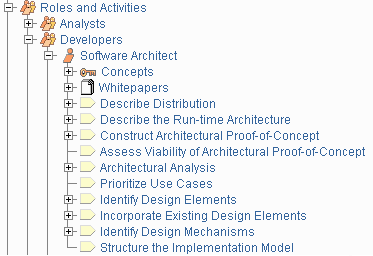Key Concept: Activity
Topics:
Activity 
Roles have activities that define the work they perform. An activity is something that a role does that provides a meaningful result in the context of the project. See Activity: Capture a Common Vocabulary for an example of an activity.

A typical role, showing its activities in the treebrowser
An activity is a unit of work that an individual playing the described role may be asked to perform. The activity has a clear purpose, usually expressed in terms of creating or updating some artifacts, such as a model, a class, or a plan. Every activity is assigned to a specific role. The granularity of an activity is generally a few hours to a few days, it usually involves one role, and affects one or only a small number of artifacts. An activity should be usable as an element of planning and progress; if it is too small, it will be neglected, and if it is too large, progress would have to be expressed in terms of an activity's parts.
Activities may be repeated several times on the same artifact, especially when going from one iteration to another, refining and expanding the system, by the same role, but not necessarily the same individual.
Steps 
Activities are broken down into steps. Steps fall into three main categories:
- Thinking steps: where the individual performing the role understands the nature of the task, gathers and examines the input artifacts, and formulates the outcome.
- Performing steps: where the individual performing the role creates or updates some artifacts.
- Reviewing steps: where the individual performing the role inspects the results against some criteria.
Not all steps are necessarily performed each time an activity is invoked, so they can be expressed in the form of alternate flows.
Example of steps:
The Activity: Find use cases and actors decomposes into the steps:
- Find actors
- Find use cases
- Describe how actors and use cases interact
- Package use-cases and actors
- Present the use-case model in use-case diagrams
- Develop a survey of the use-case model
- Evaluate your results
The finding part [steps 1 to 3] requires some thinking; the performing part [steps 4 to 6] involves capturing the result in the use-case model; the reviewing part [step 7] is where the individual performing the role evaluates the result to assess completeness, robustness, intelligibility, or other qualities.
